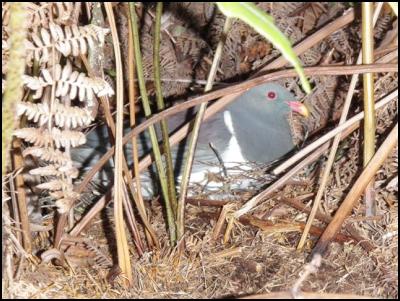Chathams parea doing better than expected

Click to enlarge
A Chatham Islands parea on its nest on the ground under bracken, found during a recent survey in the southern Chatham Island forest. (photo: Peter Dilks)
17 August 2009
Chathams parea doing better than expected
Scientists surveying endangered Chatham Islands parea (Chatham Islands pigeon) last week were were surprised to find that the population had increased to around 500, from a population low of 40 in the late 1980s.
Protection of their habitat through fencing, predator control and covenanting has reversed the decline of parea. The positive survey results could see its threat status being lowered when it is next assessed, Department of Conservation scientific officer Ralph Powlesland said.
“The speed of recovery has been impressive. While parea will still need active protection, we’re feeling a lot more positive about their long-term security,” said Dr Powlesland, who undertook the survey with DOC’s Wellington Hawke’s Bay Conservancy technical support officer Lynn Adams and other New Zealand-based fauna experts Ian Flux, and Peter Dilks, supported by the Chathams Area office.
“Habitat has been improved by the active management of browsers and predators and it’s still improving.”
Mainly confined to broadleaf forests of southern Chatham Island, parea are surveyed every five years to gauge the success of management. The surveys are undertaken during the breeding season, when the birds sit in prominent locations and undertake dramatic, and highly visible, display flights. The scientists sit on hilltop vantage points to count them and estimate the number of breeding territories.
“We were ecstatic when we returned to survey the birds last week to find such a huge increase in the population,” said Ms Adams,
“It’s a 66 percent increase in the past four years. We counted 234 birds in the core area of the forest (compared with 141 during the previous survey in 2005). When we extrapolated the information we collected over the full area of protection we realised the population was around 500.”
Predation of parea eggs, nestlings and adults by feral cats, and the degradation of some favoured parea food species, such as hoho (Pseudopanax chathamicus), through feeding by feral stock and possums led to a decline in parea numbers during the 1980s.
But their population increased dramatically over the next 20 years, after the forest was protected by fencing to exclude stock, possum and cat populations were controlled to low levels, and forest patches were covenanted by landowners; the Tuanui, Seymour, Holmes and Day families.
“We acknowledge, in particular, the significant personal input that the Tuanui family have made by way of predator control.
“While parea are still endangered, we’re more optimistic that the population will recover, and that has a lot to do with protection that landowners are giving to their land,” Ms Adams said.
She said that with the recent covenanting and fencing in the southern forest we could expect greater parea numbers in future as the forest recovered from browsing.
--
Find out more about parea on the DOC
website: http://www.doc.govt.nz/conservation/native-animals/birds/land-birds/nz-pigeon-kereru/facts/
ENDS


 NZ Banking Association: Banks Step Up Customer Scam Protections And Compensation
NZ Banking Association: Banks Step Up Customer Scam Protections And Compensation The Reserve Bank of New Zealand: CoFR Seeking Feedback On Access To Basic Transaction Accounts
The Reserve Bank of New Zealand: CoFR Seeking Feedback On Access To Basic Transaction Accounts 2Degrees: Stop The Pings - Half Of Kiwis Overwhelmed By Notifications
2Degrees: Stop The Pings - Half Of Kiwis Overwhelmed By Notifications Electricity Networks Association: How Many More Trees Need To Fall On Power Lines Before The Rules Change?
Electricity Networks Association: How Many More Trees Need To Fall On Power Lines Before The Rules Change? Parrot Analytics: Netflix Earnings - Price Hikes With Minimal Churn | Will Netflix Be A Bright Spot For Markets?
Parrot Analytics: Netflix Earnings - Price Hikes With Minimal Churn | Will Netflix Be A Bright Spot For Markets? Canterbury Museum: Mystery Molars Lead To Discovery Of Giant Crayfish In Ancient Aotearoa New Zealand
Canterbury Museum: Mystery Molars Lead To Discovery Of Giant Crayfish In Ancient Aotearoa New Zealand



